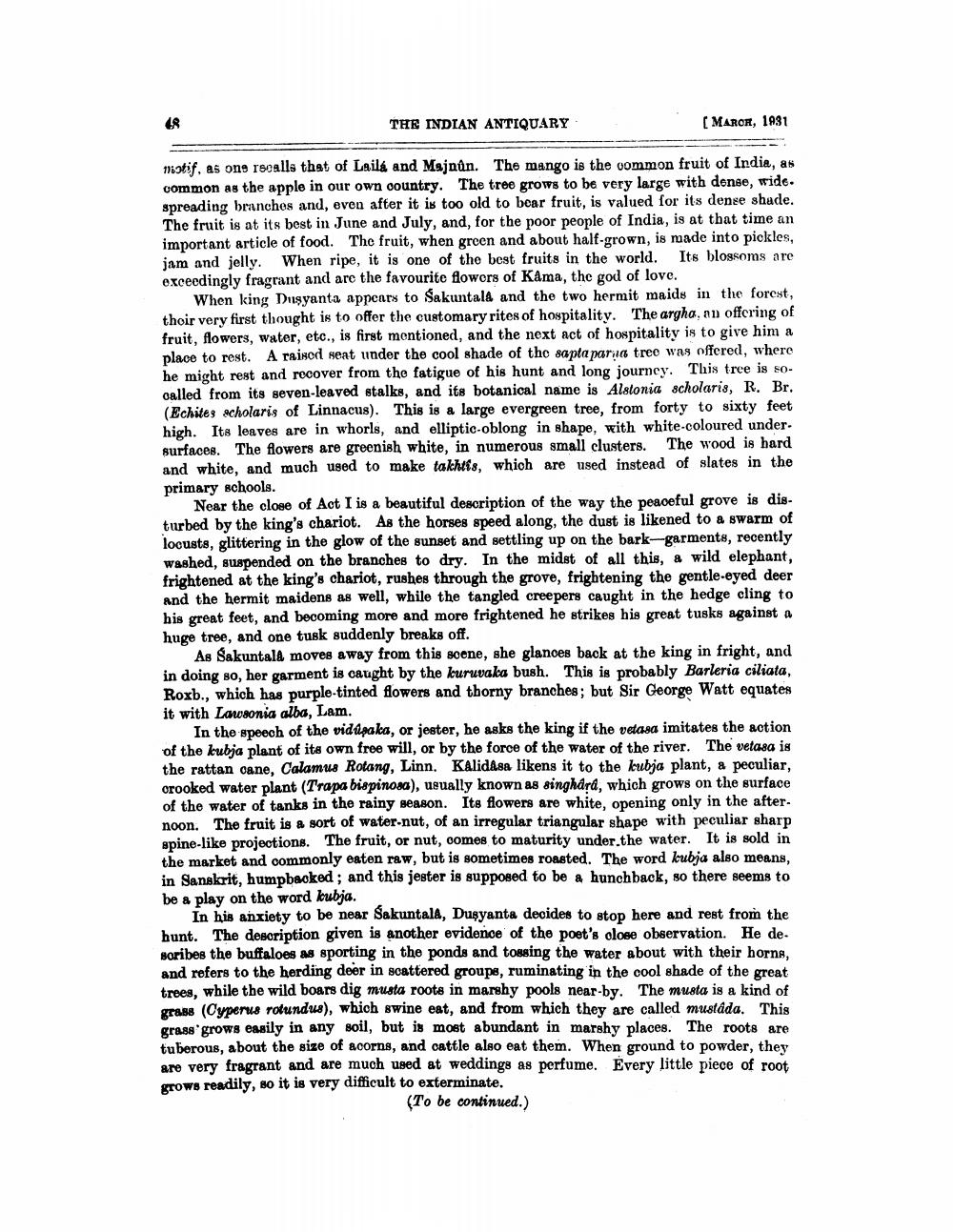________________
THE INDIAN ANTIQUARY
[MAROR, 1831
miatif, as one rsoalls that of Laila and Majnûn. The mango is the common fruit of India, as common as the apple in our own country. The tree grows to be very large with dense, wide. spreading branches and, even after it is too old to bear fruit, is valued for its dense shade. The fruit is at its best in June and July, and, for the poor people of India, is at that time an important article of food. The fruit, when green and about half-grown, is made into pickles, jam and jelly. When ripe, it is one of the best fruits in the world. Its blossoms are exceedingly fragrant and are the favourite flowers of Kama, the god of love.
When king Dusyanta appears to Sakuntala and the two hermit maids in the forest, thoir very first thought is to offer the customary rites of hospitality. The argha, an offering of fruit, flowers, water, etc., is first mentioned, and the next act of hospitality is to give him a place to rest. A raised seat under the cool shade of the sapta para tree was offered, where he might rest and recover from the fatigue of his hunt and long journey. This tree is socalled from its seven-leaved stalks, and its botanical name is Alstonia scholaris, R. Br. (Echites scholaris of Linnacus). This is a large evergreen tree, from forty to sixty feet high. Its leaves are in whorls, and elliptic-oblong in shape, with white-coloured under. surfaces. The flowers are greenish white, in numerous small clusters. The wood is hard and white, and much used to make takhtis, which are used instead of slates in the primary schools.
Near the close of Act I is a beautiful description of the way the peaceful grove is disturbed by the king's chariot. As the horses speed along, the dust is likened to a swarm of locusts, glittering in the glow of the sunset and settling up on the bark-garments, recently washed, suspended on the branches to dry. In the midst of all this, & wild elephant, frightened at the king's chariot, rushes through the grove, frightening the gentle-eyed deer and the hermit maidens as well, while the tangled creepers caught in the hedge cling to his great feet, and becoming more and more frightened he strikes his great tusks against a huge tree, and one tusk suddenly breaks off.
As Sakuntald moves away from this soene, she glances back at the king in fright, and in doing so, her garment is caught by the kuruvaka bush. This is probably Barleria ciliata. Roxb., which has purple-tinted flowers and thorny branches; but Sir George Watt equates it with Lawsonia alba, Lam.
In the speech of the vid apaka, or jester, he asks the king if the vetasa imitates the action of the kubja plant of its own free will, or by the force of the water of the river. The vetasa is the rattan oane, Calamus Rotang, Linn. Kalidasa likens it to the kubja plant, a peculiar, crooked water plant (Trapa bispinosa), usually known as singhard, which grows on the surface of the water of tanks in the rainy season. Its flowers are white, opening only in the after. noon. The fruit is a sort of water-nut, of an irregular triangular shape with peculiar sharp spine-like projections. The fruit, or nut, comes to maturity under the water. It is sold in the market and commonly eaten raw, but is sometimes roasted. The word lubja also means, in Sanskrit, humpbacked; and this jester is supposed to be a hunchback, so there seems to be a play on the word kubja.
In his anxiety to be near Sakuntala, Duşyanta decides to stop here and rest from the hunt. The description given is another evidence of the poet's close observation. He de. soribes the buffaloes as sporting in the ponds and tossing the water about with their horns, and refers to the herding deer in scattered groups, ruminating in the cool shade of the great trees, while the wild boars dig musta roots in marshy pools near-by. The musta is a kind of grabe (Cyperus rotundus), which swine eat, and from which they are called mustada. This grass grows easily in any soil, but is most abundant in marshy places. The roots are tuberous, about the size of acorns, and cattle also eat them. When ground to powder, they are very fragrant and are much used at weddings as perfume. Every little piece of root grows readily, so it is very difficult to exterminate.
(To be continued.)




